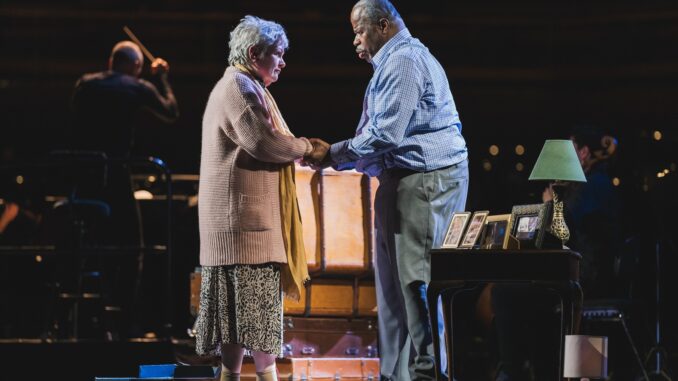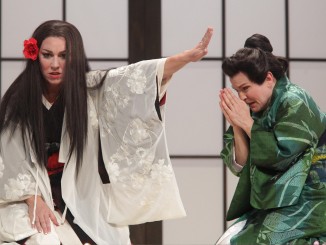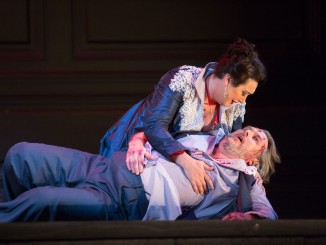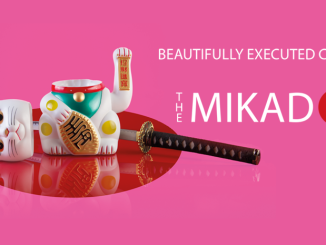
New Zealand Opera and New Zealand Symphony Orchestra’s production Bluebeard’s Castle reimagines Hungarian composer Béla Bartók’s first and only opera of the same name in English and in a modern, suburban setting. Appearing in Aotearoa for a short season of just two precious performances, this courageous contemporary opera superbly manages juxtapositions of dramatic conventions old and new, in a production that is both captivating and accessible.
First performed in 1918, Bluebeard’s Castle has its origins in a sinister and bloodthirsty Pandora’s Box style fairytale in which Bluebeard’s young bride unlocks the one room forbidden to her, discovering the corpses of her new husband’s previous wives. Bartók and Balázs’ version physicalises themes of curiosity, secrecy, isolation, and fear into seven locked doors; the hour-long one act opera traverses the conflicts and compromises of the two characters as each door reveals crucial facets of Bluebeard’s castle and by association, character. Created in 2021 as a co-production between Theatre of Sound (UK) and Opera Ventures (UK) this current interpretation of Bluebeard’s Castle presents the tale as “a love story between a long-married couple living with dementia”. The ‘doors’ become an extended metaphor, the object of focus a single locked trunk. Grisly and dramatic scenarios behind locked castle doors are poignantly replaced by everyday family keepsakes – a bridal veil, a child’s baseball cap, a funeral Order of Service. Discarding the melodrama and investing in realism facilitates vital and immediate connection and empathy from the audience, as we understand that ordinary items and actions can carry extraordinary weight.
Bluebeard’s Castle staging embraces contrast and marries unexpected choices; the presentation of the production is ambitious, flexible, and extraordinarily successful. Evocatively lit and formally dressed, the New Zealand Symphony Orchestra are in place before doors open to the audience, their numbers spilling beyond the auditorium’s stage and up into the gallery seating above. In the traditional style, Concertmaster Vesa-Matti Leppänen enters to audience applause, followed by highly-regarded Dutch-Maltese Conductor Lawrence Renes, establishing a tone of solemnity and anticipation. Against this setting, shuffling footsteps, the breaths and efforts of Bluebeard (American dramatic baritone Lester Lynch) are the opening sounds of the opera as he wanders onto to the stage, lost in thought. All of the action takes place in the limited downstage area, a minimal collection of contemporary props indicating an ordinary household setting. Costumed in everyday clothing, the two leads and five silent supporting characters hold focus flawlessly, despite their magnificent orchestral backdrop. Lighting design by Jake Wiltshire masters cohesion and contrast with a collection of household lamps, both standing and suspended, supported by bolder washes of colour from the auditorium’s lighting. Wiltshire utilises the colour symbolism present in the original Bluebeard’s Castle, while animating the lamps as a physical embodiment of the emotional landscape of the story.
At times determined, desperate, loving, and confused, Bluebeard’s wife Judith (English dramatic soprano Susan Bullock) pleads with her husband to unlock the trunk and uncover the treasures, sorrows, and memories it contains, that her mind has lost connection with. Performers playing Judith at different stages of her life, and the couple’s two children, appear as manifestations of memory, silent, familiar, and strange. Occasionally the bold dramatic conventions of traditional opera characterisation overshadow the movement naturalism at the heart of Bluebeard’s Castle, although Bullock and Lynch both succeed in establishing intimacy and authenticity overall. A mirroring motif used to connect Judith with her various selves is worthy of more exploration and development, however, the simple and effective use of props communicates the narrative of the work unfolding before us. As Judith and Bluebeard navigate the consequences of the trunk’s contents together, the richness of the music and dramatic power and nuance of the artists’ voices draw together the production’s many contrasting facets, delivering a cohesive and vibrant performance with absolute depth and integrity.
As the lighting draws the performance in on itself like a book closing, Judith sits alone, silently capturing the isolation of her condition. At the end of Bluebeard’s Castle is the longest silence I have ever experienced in a theatre, as the work lands with all its devastating power. Applause is, deservedly, extensive, and very, very warm.
Bluebeard’s Castle is presented by NZ Opera and plays Wellington’s Michael Fowler Centre 10th August and Christchurch Town Hall 12 August, 2023.
Composer: Béla Bartók
Librettist: Béla Balázs
Director & Translator: Daisy Evans
Scenic & Costume Designer: Adrian Linford
Lighting Designer: Jake Wiltshire
New Zealand Symphony Orchestra conducted by: Lawrence Renes




Leave a Reply